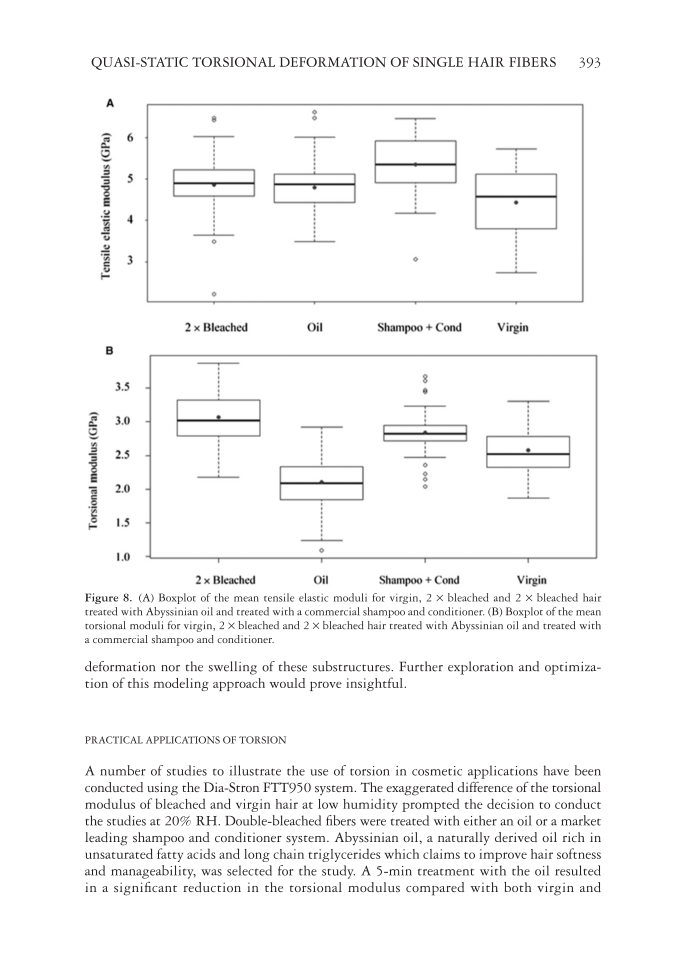JOURNAL OF COSMETIC SCIENCE 392 as a result also increases the potential for both inter and intramolecular hydrogen bond- ing. In high humidity environments, disruption of these hydrogen bonds in addition to the cleaved disulfi de bridges results in a more deformable fi ber and thus a lower elastic modulus than undamaged, virgin fi bers. As the humidity decreases, the increase in hy- drogen bonding stiffens bleached fi bers to a greater extent than virgin fi bers. Studies by Harper and Kamath (14) showed that the torsional modulus of bleached hair at low humidity is higher than that of virgin hair. At high humidity this effect is reversed, with the crossover point occurring at around 55–60% RH. Our data show a similar rela- tionship with a marked difference between virgin and 3 × bleached hair at the lowest humidity (Figure 6), most likely because of the increase in hydrogen bonding due to the harsh bleaching. Separation of the cuticle and cortex contributions to the torsional modulus using the mod- eling approach described previously (Figure 7, Table II), hypothetically illustrates the increased stiffness of the cuticle at low humidity, particularly for the bleached hair. This is likely because of an increased amount of hydrogen bonding within the endocuticle and the matrix or an increase in electrostatic interactions. Although this modeling approach may account for the potential signifi cant contribution of the cuticles to the overall torsional modulus, it does not make any allowance for the role in which the matrix plays in torsional Table III Means Values for the Tensile and Torsional Elastic Moduli for Virgin, 2 × Bleached and Treated Hair Fibers Treatment Tensile modulus, E (GPa) Torsional modulus, G (GPa) Virgin 4.43 (b) 2.58 (a) 2 × Bleached 4.86 (b) 3.07 (b) 2 × Bleached, shampoo + cond. 5.35 (a) 2.83 (c) 2 × Bleached + oil 4.79 (b) 2.18 (d) Measurements were all conducted at 20% RH. A one-way analysis of variance was used to identify any sig- nifi cant differences between the tensile modulus groups. Post hoc analysis was conducted using the Tukey Honesty Signifi cant Difference (HSD) test. Groups that do not share a letter are signifi cantly different at the 95% confi dence level. The same analysis was conducted for the torsional modulus test groups. Table II Means for the Experimental Torsional Storage Modulus of Virgin European and 3 × Bleached Hair at 20, 50, and 80% RH RH (%) Experimental Predicted G (GPa) GCuticle GCortex Virgin 20 1.50 2.32 1.20 50 1.34 2.24 1.01 80 0.81 1.39 0.60 3 × Bleached 20 1.96 4.33 1.09 50 1.84 3.27 1.33 80 0.62 1.35 0.35 The theoretical values of GCuticle and GCortex have been calculated using the approach described in (23) based on a sample size of 45.
QUASI-STATIC TORSIONAL DEFORMATION OF SINGLE HAIR FIBERS 393 deformation nor the swelling of these substructures. Further exploration and optimiza- tion of this modeling approach would prove insightful. PRACTICAL APPLICATIONS OF TORSION A number of studies to illustrate the use of torsion in cosmetic applications have been conducted using the Dia-Stron FTT950 system. The exaggerated difference of the torsional modulus of bleached and virgin hair at low humidity prompted the decision to conduct the studies at 20% RH. Double-bleached fi bers were treated with either an oil or a market leading shampoo and conditioner system. Abyssinian oil, a naturally derived oil rich in unsaturated fatty acids and long chain triglycerides which claims to improve hair softness and manageability, was selected for the study. A 5-min treatment with the oil resulted in a signifi cant reduction in the torsional modulus compared with both virgin and Figure 8. (A) Boxplot of the mean tensile elastic moduli for virgin, 2 × bleached and 2 × bleached hair treated with Abyssinian oil and treated with a commercial shampoo and conditioner. (B) Boxplot of the mean torsional moduli for virgin, 2 × bleached and 2 × bleached hair treated with Abyssinian oil and treated with a commercial shampoo and conditioner.
Purchased for the exclusive use of nofirst nolast (unknown) From: SCC Media Library & Resource Center (library.scconline.org)









































































































